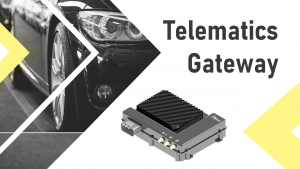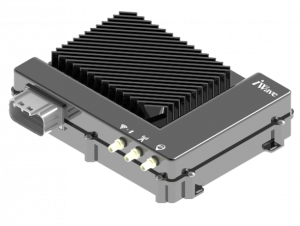Telematics Gateways & Over-the-air (OTA) for Electric Vehicles
Technological disruptions are transforming the automotive industry, and among these changes is the shift to electric vehicles or EVs. According to Bloomberg New Energy Finance, EVs will represent 57% of worldwide passenger car sales by 2040. As electric vehicles invariably expand in the market, the need for software fixes and upgrades as part of their regular maintenance becomes vital.
Over-the-air (OTA) technology plays a crucial role in enabling a vehicle’s performance and features to be continuously updated and improved. With modern electric vehicles running on central computing system systems powered by millions of lines of code, OTA solutions can seamlessly manage these software components through wireless monitoring.
Through OTA services, companies can deploy new patches, software, or firmware to EVs in their networks over the air without ever recalling those devices or interrupting their customer. Hence an EV owner does not have to go to a service center on the occurrence of any software issue but get it looked after remotely.
There are two types of OTA updates,
- Software Over-The-Air (SOTA)
It is a relatively simple software update that modifies the physical or electronic aspects of the car. SOTA updates tend to apply to user interfaces such as infotainment screens and navigation.
- Firmware Over-The-Air (FOTA)
FOTA updates are slightly complicated compared to SOTA since they can change the way a vehicle behaves. It includes improved range, better performance, and changes in how the power is delivered.
Hence, SOTA updates are simple fixes for security patches, bugs, or minor feature updates. Whereas FOTA updates are like installing a completely new operating system that demands cybersecurity, speedy connectivity, massive computing power, and more time to install.
Battery management in EVs
In electric vehicles, where software is practically everywhere this form of management is very valuable. It is observed that consumers are primarily concerned about the battery range of EVs when considering their adoption. OTA addresses this issue by collecting precise data. Battery consumption data can be collected and sent to a central cloud server, which can then be processed and made available for analysis by data scientists. This analysis can be improved further through dedicated AI and machine learning algorithms to derive actionable insights for software and configuration adjustments. It is thus possible to optimize battery performance by detecting potential failures preemptively, as well as improve the scheduling of service.
So, how do OTA updates work? OTA updates are delivered remotely using companies’ cloud-based server. OTA service clouds utilize content delivery networks to communicate with vehicles over secure networks. The server contains a wide range of repositories providing vehicle manufacturers with a workspace for updating software.
For OTA updates to function, the vehicle must include a telematics device such as a telematics control unit (TCU) or telematics gateway. These devices are a piece of hardware that supports wireless technologies such as 4G cellular support, Wi-Fi, Bluetooth, and memory for storing and driving vehicle data. Telematics devices download these software updates via Wi-Fi or cellular networks and install them. In case an update needs to be undone, the device also has the capability to recover the data.
The telematics gateway serves as the backbone for EV OTA updates. It offers automakers a flexible and modular computing platform that allows data exchange between multiple electronic control units (ECUs) and servers. The telematics gateway also provides a secure execution environment and prevents unauthorized access to the device while maintaining data integrity.
Key features of Telematics Gateway
- i.MX 8 DXL CPU with 64-bit ARMv8 Architecture
- Wireless communication
- Wi-Fi 802.11a/b/g/n/ac with optional support for 802.11ax, BLE 5.0
- 4G/LTE Cat 4/Cat M1 for fast M2M/IoT applications
- Wired interfaces
- RS232, RS485, Automotive Ethernet, and Analog Inputs
- Real-time Vehicle Monitoring
- CAN FD/HS CAN/LS CAN Interfaces
- ISO 15765-4 CAN, SAE J1939, ISO 11898, CANopen, and CiA 447
- 3-axis gyroscope, accelerometer, and magnetometer for real-time motion monitoring, driver behavior analysis, and auto-calibration
- High-precision GNSS Module – GPS/GLONASS/BeiDou/Galileo
OTA updates with iWave Telematics Gateway
The simplest way to update a device is by writing the new file system image directly to the flash partition. The telematics gateway from iWave comes with built-in redundant support, which partitions the flash memory into Kernel File System A and Kernel File System B to ensure that the device resumes working after an error occurs.
OTA client will run on telematics device to facilitate over-the-air software updates. A system update involves the client writing the new file to the inactive partition. The client verifies the checksum and sets the bootloader flag to indicate that the update was successful. The active and inactive partitions flip on the next boot, and the system reboots.
If something caused the device to reboot before committing the update, the bootloader rolls back to the previous state by flipping the active and inactive partitions.
Also, Telematics Gateway has an additional data partition where modified files are stored, which is used as a backup and as a secure data partition for storing credentials and security keys.
For more information or inquiries, please contact mktg@iwavesystems.com or visit our website www.iwavesystems.com
Keep Reading
 |  |  |
| Embedded telematics: Unlocked | What is Telematics Gateway | OTA update with iWave Telematicas Control Unit |




